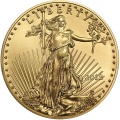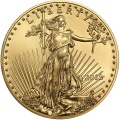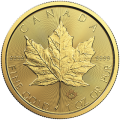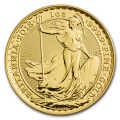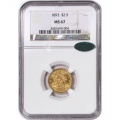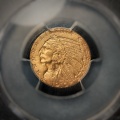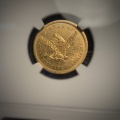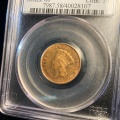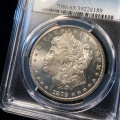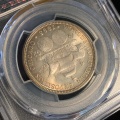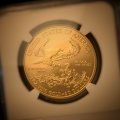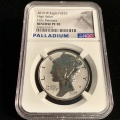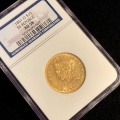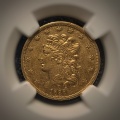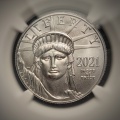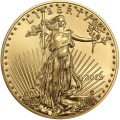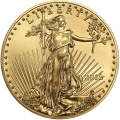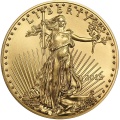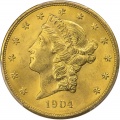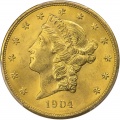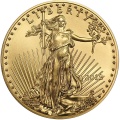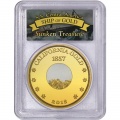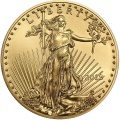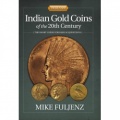By Mike Fuljenz
The just-released John F. Kennedy presidential dollar figured to be among the most popular issues in the ongoing series of $1 coins honoring the nation’s chief executives now in the ninth year of its roughly 10-year run. JFK was young, handsome, dynamic and engaging, and these qualities – combined with his peerless gift for public speaking – captivated his countrymen during his all-too-brief tenure in the White House. His shocking assassination transformed Americans’ admiration into adulation and ensured that these images would endure, as if frozen in time, in the nation’s collective consciousness.
Over the years, the image of John Kennedy that has dominated most people’s memories is that of a resolute leader confidently facing the myriad challenges confronting the United States as it entered what he called a “New Frontier.” The Kennedy half dollar, first issued just four months after JFK’s tragic death, helped crystallize this image through its strong portrayal of Kennedy gazing ahead with a calm yet determined look upon his face.
JFK was so popular at the time of his death that people lined up for blocks outside banks to acquire the new half dollar when it was released in March 1964. His image has lost little luster in the intervening years. Polls conducted by CNN and Gallup in 2013 found JFK to be the most popular U.S. President of the last half century.
Nor has his appeal been limited to his fellow-Americans. He was greatly admired 50 years ago – and still is today – by people around the world. In 1976, when my wife lived with a local family in Ireland during her physical therapy internship in that country, two large photographs occupied places of honor in their home – one of the Pope, the other of President Kennedy.
Like other Kennedy portraits, including the one on the JFK half dollar, the picture in that Irish home was straightforward, as if fixed upon the future. Due in large measure to this widely shared mental image, many Americans have mixed emotions about the JFK portrait on the newly struck presidential dollar and some have serious reservations – if not feelings of downright dislike. That’s because this new portrait, in stark contrast to most previous likenesses, is serious, almost somber, and shows a side of JFK little explored in the past: his acute awareness of the dangers facing America and deep anxiety that they might overwhelm the nation – and him – despite the upbeat demeanor he unfailingly displayed in public.
The portrait is the work of Don Everhart, a senior sculptor-engraver on the U.S. Mint’s roster of staff artists. It depicts a contemplative JFK looking down and seemingly lost in thought, with lines around his eyes underscoring the strains that undoubtedly sapped his strength throughout his 34-month presidency.
I’ve heard some people say the portrait doesn’t look like JFK. What they’re really saying, I think, is that it doesn’t look like the JFK they remember or, if they’re too young to have lived through the Kennedy years, it doesn’t look like the mental image they’ve formed after viewing old television and film clips.
I like the portrait. And after looking into how it came about, I learned that it has an important precedent – one that served as an influence and inspiration for Don Everhart. It turns out that Kennedy’s official presidential portrait – the one that hangs in the White House – also captures JFK in a reflective moment, with his head bowed, his eyes downcast and his arms crossed. The artist, Aaron Shikler, later explained that the oil painting was based, in part, on a photograph of the President taken at the time of the Cuban Missile Crisis, when the fate of mankind rested quite literally on his shoulders.
The portrait was painted in 1970, seven years after the assassination, and was closely monitored by Kennedy’s widow, Jacqueline, who not only commissioned Shikler but also gave him detailed instructions on how she wanted the President to be shown.
The artist vividly recalled the circumstances, which he recounted in a 1981 article in People magazine.
“I don’t want him to look the way everybody else makes him look, with bags under his eyes and that penetrating gaze. I’m tired of that image,” the former First Lady told him, Shikler said.
Shikler remembered seeing a photo of the President’s brother, Ted, grieving at JFK’s funeral in November 1963 with his arms crossed and his head bowed. The artiste made a sketch from that photo, he told People, and that was the image Kennedy’s widow chose to represent her husband in the final portrait.
“All I wanted to portray was a man who looked like he could think,” Shikler explained.
I was struck at once by Jackie’s close involvement with the process and by the fact that the Kennedy painting differs greatly from previous presidential portraits, just as the coinage portrayal of JFK on the new presidential dollar stands in clear contrast to earlier ones.
Keep in mind that Jacqueline Kennedy also played an important role in shaping the final look of the Kennedy half dollar. Given an opportunity to provide her input on that JFK portrait, which was designed by the Mint’s chief sculptor-engraver, Gilroy Roberts, she asked for revisions in the way the hair was shown – and these, of course, were made. As a result, a distinct variety – known by collectors as the “accented-hair” variety – exists for proof 1964 half dollars struck before the change was implemented. Coins of this variety display stronger hair lines than those minted following the change.
To my mind, Don Everhart captured what Jackie would have liked, given the design of the presidential painting. What’s more, I think the President himself would have approved. I base that conclusion on a story my parents told me many years ago regarding brief interaction they had with Jack and Jackie Kennedy at a 1959 banquet in Lake Charles, Louisiana, not far from where we lived.
Kennedy hadn’t yet formally declared himself a candidate for President in the 1960 election, but speeches at gatherings such as this were obviously intended to rally support behind him once the campaign officially began.
My father was a prominent attorney and my mother was a history teacher, and both took an active interest in civic and political affairs. During the course of the evening, my mom asked Kennedy, then a U.S. senator from Massachusetts, to write something inspirational for her pupils on the back of the dinner menu. JFK obliged by jotting down a quote from Daniel Webster, a statesman and orator who likewise had served as a Massachusetts senator in the mid-1800s. Kennedy had written about Webster in his Pulitzer Prize-winning book Profiles in Courage several years earlier.
Quoting Webster, Kennedy wrote:
“Let us develop the resources of our land, call forth its powers – build all of its great interests – and see whether we also in our day and generation may not perform something worthy to be remembered.”
When he came to the phrase “build all of its great interests,” JFK initially used the word “develop” instead of “build.” According to my mom, Jackie leaned over and politely suggested a correction to “build.” At that point, Mom told me, Jack quickly put a line through “develop,” wrote “build” above it, and continued.
That menu, bearing Kennedy’s handwritten message of encouragement, hangs proudly in my home today. And it serves as not only a cherished memento, but also graphic evidence that the future President trusted his wife’s knowledge and judgment completely. And that’s all the more reason to believe he would have agreed with her choice of a serious, contemplative portrait on the painting – and, by extension, an introspective likeness on the new presidential dollar.
I fully endorse Don Everhart’s design. Others will surely persist in their objections – especially the notion that it “doesn’t fit in” with other designs in the series. I urge them, though, to keep an open mind.
One piece of advice I often give people is not to jump to conclusions simply on the basis of first impressions. Take a deep breath and weigh all the pros and cons before you make a final decision. The JFK portrait certainly stands out from the other designs in the dollar coin series – including artist Everhart’s likeness of Harry S Truman on the Truman dollar issued earlier this year. But is this a detriment or a dividend? Does its singular appearance make it even more collectible, not less?
These are personal judgments, and I don’t expect to change too many minds by setting forth my reasons for feeling as I do. John F. Kennedy was a different kind of President – the youngest ever elected, the first (and so far only) Roman Catholic and a Navy and Marine Corps Medal recipient for his heroism during World War II, to cite three important examples.
In my view, such a President deserves a coin that likewise bears a different kind of image.
Ultimately, time will be the judge of who was right.


